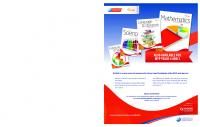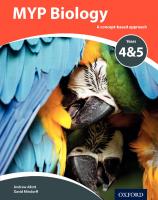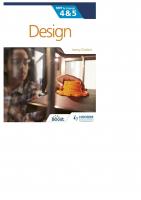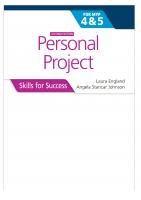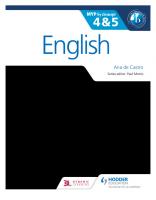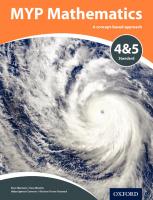IB MYP 4 and 5 Chemistry 0198369964, 9780198369967
Drive achievement in the MYP and strengthen scientific confidence. Equipping learners with the confident scientific unde
164 88 245MB
English Pages [356] Year 2018
Recommend Papers

- Author / Uploaded
- Gary Horner
File loading please wait...
Citation preview
MYP Chemistry A concept-based approach
Yea rs
4&s
t!1
MYP Chemistry A concept-based approach
Years
4&s
OX_FORD \INIYERSITY PRESS Great Clarendon Street, Oxford, OX2 6DP, United Kingdom
Oxford University Press is a department of the University of Oxford.
It furthers the University's objective ofexcellence in research, scholarship, and education by publishing worldwide. Oxford is a registered trade mark ofOxford University Press in the UK and in certain other countries @
Oxford University Press, 2018
The moral rights ofthe authors have been asserted First published in 2018
All rights reserved. No part ofthis publication may be reproduced, stored in a retrieval system, or transmitted, in any form or by any means, without the prior permission in writing of Oxford University Press, or as expressly permitted by law by licence or under terms agreed with the appropriate reprographics rights organization. Enquiries concerning reproduction outside the scope ofthe above should be sent to the Rights Department, Oxford University press, at the address above. You must not circulate this work in any other form and you must impose this same condition on any acquirer
British Library Cataloguing in Publication Data Data available 978-0-79-836996-7
10987 654321
./} FSC
Mtx FSCp
C007785
Paper used in the production ofthis book is a natural, reryclable product made fiom wood grown in sustainable forests. The manufacturing process conforms to the environmental
regulations of the country of origin. Printed in Great Britain by Bell and Bain Ltd. Glasgow
Acknowledgements The authors and publisher are grateful to those who have given permission to
reproduce the following extracts and adaptations of coplright material: American Chemical Society National Historic Chemical landmarks. 'Flavor Chemistry Research, USDA ARS Western Regional Research Center,' produced by the National Historic Chemical landmarks program of the American Chemical Society in 2013. Reproduced by permission. Paul Anastas and John Warner: Green Chemistry: Theory and practice (199g) Fig.4.1 p.30. www.oup.com. By permission of Oxford University press.
'Climate Model Suggests Collapse ofAtlantic Circulation is possible, 4 January 20'17 from Scripps Institution of Oceanography at UC San Diego. Reproduced by permission.
Definition of 'Alalytical Chernistry'fiom https://www.nature.com/subjects/ analytical-chemistry. Reproduced by permission.
Definition of 'Analytical Chemistry' from www.acs.org/content/acs/en/careers/ college-to-career, American Chemical Society. Reproduced by permission.
M G Carlin & J R. Dean: Extract fiom 'Forensic applications ofgas chromatography', 1 January 2013. Reproduced with permission ofTaylor and Francis Group LLC Books via Copyright Clearance Center. Richard L Clark: Extract fiom 'Environmentally Friendly Anti-Corrosion Coatings'. United States Environmental Protection Agenry, https://cfoub.epa. gov. Reproduced by permission. Exffact {iom 'All About Glaciers,' National Snow and Ice Data Center. Accessed 1 February 2016. https://nsidc.org/cryosphere/glaciers. Extract Iiom'Califomia ramps up biofuels infrastmcture' fiom hftps/lwww.afdc. eners/.gov 13 October 2016. Reproduced by permission.
Extract Iiom United Nations World Food Programme, www.wfu.org. Reproduced by permission.
Thomas McCullough, Marissa Curlee:'qualitative analysis of cations using paper chromatography' from.fou rnal of Chemical Education Copyright @ 1993, American Chemical Society. Reprinted with permissiorrfrom the American Chemical Society. Matthew Nitch Smith: 'The number of cars worldwide is set to double by 2040', April 4, 2016, Busmess In sider Magazine., Copyrighted 2016. Business Insider, 260041:0318PF. Reproduced by permission ofWright's Media. 'Projected Global Transport Growth over the next 25 years' infographic, April 4, 2016, Business Insider Magazine, @ HS, IAIA, World Bank, iMF and
Bernstein. Reproduced by permission of AllianceBernstein. Michael Reilly and Jamie Condliffe: A Desert Full of Tomatoes, Thanks to Solar Power and Seawater', October 6, 2016, MIT Technology Review lournal, Copyrighted 2016. Technology Review. 260318:0418SH. Reproduced by permission of Wright's Media. 'Vvhat is Acid Rain' fiom United States Environmental protection Agency, m.epa.gov/acidrain/what-acid-rain. Reproduced by permission. XiaoZhi Lim: 'The new breed of cutting-edge catalysts' fiom .Nature News', 6 September 2016 published by Nature Publishing Group. Reproduced by permission of fughtslink.
Contents How to use this book
iv
Mapping grid
v
1 2 3 4 5 6 7 8 9
Balance
2
Evidence
26
Consequences
60
Energy
84
Conditions
108
Form
134
Function
162
lnteraction
190
Models
212
10 Movement 11 Patterns 12 Transfer
246
Glossary
328
lndex
339
Answers
www.oxfo
276 304
rd seco n da
ry.com/myp-scie n ce-s u p port
How to use this book To help you get the most of
your book, here's an overview of its features.
Concepts, global context and statement of inquiry
The key and related concepts, the global context and the statement of inquiry used in each chapter are clearly listed on the introduction page.
Activities A range of activities that encourage you to think further about the topics you studied, research these topic and build connections between chemistry and other disciplines.
Worked example Worked examples take a step-by-step approach to help you translate theory into practice.
Experiments and demonstrations Practical activities that help you prepare for assessment criteria B &
C
Data-based questions These questions allow you to test your factual understanding of chemistry,
well as study and analyze data. Data-based questions help you prepare for assessment criteria A, B & C. as
! stils These approaches to leaming sections introduce new skills or give you the
opportunity to reflect on skills you might already have. They are mapped to the Myp skills clusters and are aimed at supporting you become an independent leamer.
ffi
e
conceptual
question @
a debatable question
Summative assessment There is a summative assessment at the end of each chapter; this is structured in the same way as the eAssessment and covers all four MYP assessment criteria.
Glossary The glossary contains definitions for all the subject-specific terms emboldened in the index.
Mapping grid The MYP eAssessment subject list for Chemistry consists of seven broad topics:
table [\4atter
lnternational Union of Pure and Applied
Periodic
Pure and impure
Chemistry
substances
The atmosphere
Bonding
Types of chemical reaction
These topics are further broken down into sub-topics and the mapping grid below gives
you an overview of where these are covered within this book. It also shows you which key concept, global context and statement of inquiry guide the learning in each chapter. Chapter
Topics covered
Key concept
i
Chemicalformula
Relationships
Balance
Global context
Statement of inquiry
ATL skills
Fairness and
mbalanced relationships affect finite resources, both locally and globally.
Reflective skills: Develop new techniques and strategies for effective learning
development
Chemical reactions and the conservation
I
of mass
skills,
Thinking in context: Finite TCSOU TCES
Balancing equations
lnformation literacy and communication skills:
Reversible reactions
Read critically and for
comprehension
Thinking in context: Falrness and development
Thinking in context: It/onocultures and food security
Thinking in context: Fertilizers vs. pesticides, and CCD
2 Evidence
Metals and nonmetals
Relationships
Scientific and technical
innovation
Transition metals
Our ability to collect evidence improves with advances in science and technical innovations.
Noble gases Fractional distillation of crude oil
Critical thinking skills: Using inductive and deductive reasoning
Critical thinking skills: Understanding based on new information and evidence lnformation and media literacy: Communicate information and ideas effectively
Alkanes, alkenes,
alcohols
Atmospheric composition 3 Consequences
Acids and bases
Neutral solutions Acid/base reactions, pH and indicators Formation of salts Reactivity series Emissions and
environmental implications
Change
Globalization and sustainability
Change as a consequence of human development can be
identlfied within all environments on our planet.
Critical thinking skills: Analysing and evaluating issues and ideas
Thinking in context: Rising sea levels
Thinking in context: Battery disposal
Thinking in context Carbon dioxide emissions
Chapter
Topics covered
4 Energy
Endothermic and Change exothermic reactions
Key concept
Energy changes in a
Statement of inquiry
ATL skills
Scientific and
Scientific and
Thinking in context:
technical innovation
technological adva nces can enable functional energy transformations within, and between,
increasing energy usage sustainable?
Global context
reaction States and
ls
our
systems.
properties of matter Combustion of fuel 5 Conditions
Collision theory
Systems
Scientific and
technical innovation
Chemical reaction kinetics rates
Scientific innovations advance a scientist's
Factors affecting rates - temperature,
ability to monitor chanqes in conditions and the effect they have on the rate of a chemical
concentration,
reaction.
Critical thinking skills: Revising your understanding based on new information and evidence Critical thinking skills: Evaluating evidence and arguments
surface area,
Refl
catalysts
content
ective skills: Considering
Research skills: Gathering and organizing relevant information Research skills: Presenting information and data using models and mathematical relationships 6 Form
States and
Relationships
properties of matter
ldentities and
Observing and describing
Communication skills:
relationships
the properties of
Organize and depict information loglcally
a
substance helps us to understand its identlty and how it interacts with the environment.
Characteristics of 9ases
Solutions, colloids and suspensions Filtration and
fractional distillation 7 Function
Formation of salts
Relationships
Filtration,
distillation and chromatography
Globalization and sustainability
The mole concept and chemical calculations
The way in which matter
functions is dependent on its propertles and the relationship of the dlfferent systems within the environment.
lnformation literacy skills: Finding, interpreting, judging and creating information
lnformation and media literacy skills: Locate, evaluate, synthesize information from a variety of sources Reflection skills: Consider ideas
from multiple perspectives 8 lnteraction
Redox reactions
Corrosion Combustion of fuels Emission and
environmental implications Formation of salts Reactivity series
Systems
Globalization and sustainability
The interactions between substances can sometimes be understood and predicted by examining
the underlying processes.
lnformation literacy skills: Process data and report results
Chapter
Topics covered
Key concept
Global context
Statement of inquiry
ATL skills
9 Models
Structure and
Systems
Orientation in
lvlolecular modelling is used for the visualizatlon of chemlcal structures, displaying their orientation in space and
Creative thinking skills:
bonding
space and time
Electron
configuration and valency
time.
Properties of elements and
Apply existing knowledge to generate new ideas, products or processes
Thinking in context: Assigning valence electrons of an element using the periodic
table
compounds
Communication skills:
Chemical formulae
Read critically and for
Alloys
comprehension Critical thinking skills: Combine knowledge and understanding to create new perspectives
10 Movement
Redox reactions
Change
Reactivity series
Scientific and technical
innovation
Electrochemicalcell
The changes we observe in a chemical system can help us to infer
information about the movement of molecules and their properties.
Uses of salts
Corrosion
Thinking in context: Utilizing the voltaic cell
lnformation literacy skills: Collect, organize and present information
Thinking in context: Electroplating
Extraction
Critical thinking skills:
Extraction of metals
Evaluate evidence
Diffusion 1
'l Patterns
Periodic trends groups and periods
Relationships
Orientation in
Chemists look for
space and time
patterns in the periodic table in order to discover
Atomic structure Electro
n
relationships and trends that help them to predict physical and chemical properties.
ic
configuration and va
lency
lnformation literacy and communication skills: Communicate information and ideas effectively to multiple audiences
Acid and base cha racteristics 12 Transfer
The mole concept
and chemical calculations -
concentration Acid-base reactions, pH, titrations and indicators Structural formulae
- carboxylic and esters
acids
Change
Scientific and technical
innovation
Technological advances in analytical devices enhance the ability of scientists to monitor the transfer of matter when changes occur during chemical reactions.
lnformation literacy skills: Finding, interpreting, judging and creating information
The ozone laycr is l'otir-rcl in the Llpper atmosphc're, where it acts as a filtcr preventine over 957o of harmful UV radiation emitted fron'i the Strn Ircm rcaching the Earth. Humar-r interactions with thr tnvironnteltt rrray rcsult in the release of substanccs that can calalyse tlre brcakdown of thc ozctnc ntoleculc. When the balance of thc planet's resorrrces and the rnvironmcnt is disnrptcd, the consequcnccs arc expericncec'l globally. What happens whcn the balancc' between ozonc- procluctior-r ancl ozone deyrletiur-r is clisturbed?
Fertiiizcrs are easily solubilizcd in the soil, rapidly Lrrr:aking down into artrr-nonia. Solutrlc atllmonia calttured in rainwater can wash into aquatic environr.nents resulting in an intbalance allccting the natttral ecosystems and comnrercial aquaculture industries. Tl"ris often results in thc' rapicl growth of algae in poncls anc'l streams. What is tl-rc irnpact of this increasccl anroLrnt of algae?
Carnping ancl rnakirrg a canplire are enjo1,'able recrcational activities. Whcn woocl LrLrrns, is the re an increasc ir-r disorder? Mattcr r-rnclergoes a change of state. Is nrattcr still conserved? Can all nratter in this courbusliorr rcaction [)e accor-rntccl for?
-- frr-
r{l
first law of nrotion was proposed iry Sir Isaac Ncwton in 1(r86. Rcgarded as the clelinition ol inertia, it states that an obiect will remain at resl rlr kcep moving in a straight line, unlcss the l'orces acting on the object beconre unbalanced clrrc to an external force being applied. Voyagcr 2 is a dccp space probe that was launched b1, NASA ir't l977.lt will maintain an approxinrate speed of 55,000 krn hr inclefinitell,Lrnlc'ss the forces actilrg rrpon it bcconre unlralancc'cl. How has Nerarlon's Iirst law of nrotion helped Lls to cxplorr tlle Universc that rnre live in?
Tl-re
BALANCE
lntroduction Key concept: Relati or-rslr ips
Related concept: Balancc Globa! context: Fairness and deve Iopme lrt
Systems within our universe are dynamic. They constantly undergo both internal and external changes, which require these systems to react and respond. Biological organisms rely on the process of homeostasis to regulate changes that occur within systems and maintain balance. Ecosystems are a dynamic environment of multiple components. Abiotic components include the physical surroundings such as sunlight, water and the soil in which the plants grow. Biotic components include the producers and consumers living within the ecosystern. All of these components contribute to maintaining the balance in conditions and relationships. Uncontrolled development applies external pressures on ecosystems, resulting in an imbalance.
Chemical and physical systems display characteristics that involve a balance in matter and energy, referred to as equilibrium. The control over the balance between reactants and products is essential in many industrial processes and syr-rthetic reactions.
rrih
"
&
'C,.".".
Imbalanced relationships affect flnite resources, both locally and globally.
Is
G@
there balance within the universe?
Systems within the universe fall into and out of balance constantly. Imbalanced relationships often have far-reaching effects, so our ability to understand the reasons why a system becomes unbalanced, and in turn rebalanced, is of fundamental importance. In our everyday lives, we too experience changes in balance.
.
Biological systems undergo continual change, and to maintain balance is challenging. The diversity of ecosystems, organisms and micro-climates across our planet is immense; and marine environments are some of our planet's largest ecosystems.
a
The relationship between organisms and their environments is delicate balance.
o
When excess amounts of nutrients enter a marine ecosystem as the result of increased industrial or agricultural runoff or natural changes in the amounts of available nutrients, this can have a signiflcant and destructive impact.
a
What are examples of entropy in daily life? Entropy (S) is defined in chemistry as a measure of the distribution of total available energy between particles in a system. The conservation of energy is a fundamental principle of science. When a system has decreasing order and increasing disorder, it is said that its entropy is increasing. However, the total energy within the system remains balanced even when it is distributed in a different way.
6+
h-"JD: *.d
"r@;T. (E** *!D 5-
A
5-
6+
'tr"
*,fq** 6+
6+
NaCl(s)+ H,O(l)--+ UaCl(aq) When you dissolve sodium chloride in water, the solid ionic compound breaks down into its ions.This change of state from a solid to a liquid is an example of an increase in entropy The solid lattice structure of sodium chloride is broken down and the ions are free to move in the solution. The amount of disorder increases
A
Harmfulalgalblooms in marine ecosystems have a major impact within these environments causing an imbalance in the ecosystem. How is aquafarming affected by these occurrences? How might this be a threat to human health? PHYS I CAL
BALANCE
i
Reflective skills
Develop new skills, techniques and strategies for effective Iearning Knowledge, skills and understanding are the trilogy of learning. When you graduate from high school, you should aim to take with you knowledge, the skills necessary to acquire knowledge and an understanding of the concepts that you have studied. I(nowledge consists of facts and flgures that are ready for you to use. They are often easy to recall and many times are not open to debate. Examples of knowledge in chemistry include:
o a
The three main states of matter: solids, liquids and gases. The formulae of elements and compounds. For example, with oxygen, the element has the symbol O and the formula of the compound oxygen is Or.
o In a chemical reaction,
reactants are on the left-hand side of a chemical equation and products are on the right-hand side.
. .
Acids are corrosive and have a low pH. The main greenhouse gas is carbon dioxide with a chemical formula of COr.
Skills are the strategies you develop in order to acquire knowledge and build understanding. The Approaches to Learning skills that we will encounter through this book will help you develop the necessary skills to build your knowledge base and deepen your understanding of scientifi c concepts. Understanding is your ability to use your skills and your knowledge, apply them to new contexts and advance your understanding of a concept. It is your understanding of the concepts that enables you to build your knowledge base.
Entropy in your daily Iife With the definition of entropy in mind, brainstorm in a small group within your class and identify systems that make up our daily life that have either increasing or decreasing entropy. Justify your choices with supporting arguments. When you have decided on your examples, collectively decide on an effective way to summarize your inlormation so that it can be presented to the other members of the class. Remember that it is important to acknowledge other people's work by creating references and citations in your presentations.
Both languages and symbols are forms of communication that transcend borders, allowing global citizens to communicate with each other. The scientific community uses elemental symbols, formulae and balanced chemical equations to communicate large amounts of information, enabling us to understand what elements and compounds are involved in a chemical reaction.
ETE@
What can a balanced chemical equation tell us about a reaction? The study of chemical reactions focuses on substances that are undergoing change. A clear understanding of the energy changes occurring in a chemical reaction is also essential if we are to understand how the reaction occurs under a given set of conditions The changing balance in energy between reactants and products needs to be understood. Energy can neither be created nor destroyed, but is converted from one form of energy to another or transferred from one substance to another. The relationship that exists between a system, its surroundings and the universe is well understood (see Chapter 5, Conditions).
.ELIi]TIDTTS
''"tN'
ooooeo@@ 4tJ15676
@(Do@o@o@ o@@o 9lollt2Bralt16
17t6l9b
Bruatl'
oo@oooooo 2t
99
24
'3
7,
96r7rED
uil.r
ooo o@ orc ooo JI
The law of conservation of matter states that matter is neither created nor destroyed. Instead, in a chemical reaction, matter is changed from one form to another and can be accounted for at any given time.
All of the resources we use in chemical reactions are in flnite supply, but some will be rarer in terms of natural abundance and more expensive. Most reactants in chemical processes are typically less expensive or less flnite resources, and are said to be "in excess". It is fundamentally important that we understand the stoichiometric amounts of the reactants required for a given reaction, so that a valuable finite resource is the limiting reactant. A limiting reactant determines the amount of product resulting from a chemical reaction. By designing a method that attempts to completely consume the limiting reagent in the reaction, we minimize wasting valuable resources.
'5
&
"8r "%
2tunTzctary- & Satenotr
tl
35
@"
8r8
J'apo,r,rty
# s 36
A
J7
John Dalton's symbolic and visual representations of the atom, published in 1808 in lhe New System of Chemical Philosophy
,r*,11
Heat

